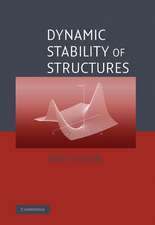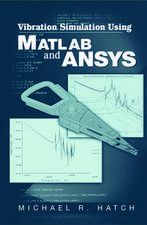Dynamics of Underactuated Multibody Systems: Modeling, Control and Optimal Design: Solid Mechanics and Its Applications, cartea 205
Autor Robert Seifrieden Limba Engleză Hardback – 20 noi 2013
| Toate formatele și edițiile | Preț | Express |
|---|---|---|
| Paperback (1) | 638.76 lei 6-8 săpt. | |
| Springer International Publishing – 23 aug 2016 | 638.76 lei 6-8 săpt. | |
| Hardback (1) | 644.95 lei 6-8 săpt. | |
| Springer International Publishing – 20 noi 2013 | 644.95 lei 6-8 săpt. |
Din seria Solid Mechanics and Its Applications
- 20%
 Preț: 698.09 lei
Preț: 698.09 lei - 24%
 Preț: 800.14 lei
Preț: 800.14 lei -
 Preț: 402.14 lei
Preț: 402.14 lei - 15%
 Preț: 640.06 lei
Preț: 640.06 lei - 15%
 Preț: 653.14 lei
Preț: 653.14 lei - 18%
 Preț: 1124.92 lei
Preț: 1124.92 lei - 15%
 Preț: 643.84 lei
Preț: 643.84 lei - 18%
 Preț: 1119.38 lei
Preț: 1119.38 lei - 20%
 Preț: 573.17 lei
Preț: 573.17 lei - 18%
 Preț: 1607.92 lei
Preț: 1607.92 lei - 17%
 Preț: 393.72 lei
Preț: 393.72 lei - 17%
 Preț: 459.40 lei
Preț: 459.40 lei - 18%
 Preț: 959.98 lei
Preț: 959.98 lei - 18%
 Preț: 747.71 lei
Preț: 747.71 lei -
 Preț: 388.55 lei
Preț: 388.55 lei - 18%
 Preț: 787.15 lei
Preț: 787.15 lei -
 Preț: 406.25 lei
Preț: 406.25 lei - 15%
 Preț: 639.08 lei
Preț: 639.08 lei - 24%
 Preț: 784.82 lei
Preț: 784.82 lei - 15%
 Preț: 643.34 lei
Preț: 643.34 lei - 18%
 Preț: 958.07 lei
Preț: 958.07 lei - 18%
 Preț: 1228.15 lei
Preț: 1228.15 lei - 18%
 Preț: 734.27 lei
Preț: 734.27 lei - 18%
 Preț: 1233.06 lei
Preț: 1233.06 lei - 18%
 Preț: 1236.19 lei
Preț: 1236.19 lei - 18%
 Preț: 950.96 lei
Preț: 950.96 lei - 18%
 Preț: 906.48 lei
Preț: 906.48 lei - 18%
 Preț: 964.54 lei
Preț: 964.54 lei - 20%
 Preț: 995.75 lei
Preț: 995.75 lei - 18%
 Preț: 953.65 lei
Preț: 953.65 lei - 18%
 Preț: 1239.67 lei
Preț: 1239.67 lei - 18%
 Preț: 962.35 lei
Preț: 962.35 lei - 18%
 Preț: 964.54 lei
Preț: 964.54 lei - 18%
 Preț: 913.11 lei
Preț: 913.11 lei - 18%
 Preț: 1226.90 lei
Preț: 1226.90 lei
Preț: 644.95 lei
Preț vechi: 758.77 lei
-15% Nou
Puncte Express: 967
Preț estimativ în valută:
123.41€ • 129.20$ • 102.11£
123.41€ • 129.20$ • 102.11£
Carte tipărită la comandă
Livrare economică 05-19 aprilie
Preluare comenzi: 021 569.72.76
Specificații
ISBN-13: 9783319012278
ISBN-10: 3319012274
Pagini: 264
Ilustrații: XI, 249 p. 81 illus., 5 illus. in color.
Dimensiuni: 155 x 235 x 20 mm
Greutate: 0.54 kg
Ediția:2014
Editura: Springer International Publishing
Colecția Springer
Seria Solid Mechanics and Its Applications
Locul publicării:Cham, Switzerland
ISBN-10: 3319012274
Pagini: 264
Ilustrații: XI, 249 p. 81 illus., 5 illus. in color.
Dimensiuni: 155 x 235 x 20 mm
Greutate: 0.54 kg
Ediția:2014
Editura: Springer International Publishing
Colecția Springer
Seria Solid Mechanics and Its Applications
Locul publicării:Cham, Switzerland
Public țintă
ResearchCuprins
1 Introduction.- 2 Multibody Systems.- 3 Feedback Linearization and Model Inversion of Nonlinear Systems.- 4 Trajectory Tracking of Multibody Systems.- 5 Model Inversion Using Servo-Constraints.- 6 Trajectory Tracking of Flexible Multibody Systems.- 7 Optimal System Design.- 8 Concluding Remarks.- Index.
Recenzii
From the reviews:
“This is a compact monograph on underactuated multibody systems. ‘Underactuated’ refers to systems with more degrees of freedom than there are actuators, or controls. … The book is well written with well-prepared figures and excellent editing. … the book is likely to be a very useful reference for those theoreticians, students, and practitioners working in one of the many areas discussed.” (Ronald L. Huston, zbMATH, Vol. 1283, 2014)
“This is a compact monograph on underactuated multibody systems. ‘Underactuated’ refers to systems with more degrees of freedom than there are actuators, or controls. … The book is well written with well-prepared figures and excellent editing. … the book is likely to be a very useful reference for those theoreticians, students, and practitioners working in one of the many areas discussed.” (Ronald L. Huston, zbMATH, Vol. 1283, 2014)
Textul de pe ultima copertă
Underactuated multibody systems are intriguing mechatronic systems, as they possess fewer control inputs than degrees of freedom. Some examples are modern light-weight flexible robots and articulated manipulators with passive joints. This book investigates such underactuated multibody systems from an integrated perspective. This includes all major steps from the modeling of rigid and flexible multibody systems, through nonlinear control theory, to optimal system design. The underlying theories and techniques from these different fields are presented using a self-contained and unified approach and notation system. Subsequently, the book focuses on applications to large multibody systems with multiple degrees of freedom, which require a combination of symbolical and numerical procedures. Finally, an integrated, optimization-based design procedure is proposed, whereby both structural and control design are considered concurrently. Each chapter is supplemented by illustrated examples.
Caracteristici
Fully self-contained treatment of underactuated and flexible multibody systems Interdisciplinary content from mechanics, nonlinear control and optimization is presented in an unified form and notation Each chapter is accompanied by one or several illustrative examples All necessary data and detailed results are provided, such that these can be used as benchmark problems














